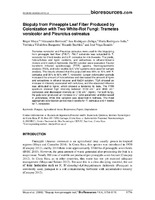Mostrar el registro sencillo del ítem
Biopulp from pineapple leaf fiber produced by colonization with two white-rot fungi: Trametes versicolor and Pleurotus ostreatus
| dc.contributor.author | Rodríguez-Zúñiga, Ana | |
| dc.contributor.author | Rodriguez-Solis, María | |
| dc.contributor.author | Villalobos-Barquero, Verónica | |
| dc.contributor.author | Vega-Baudrit, José | |
| dc.contributor.author | Moya-Roque, Róger | |
| dc.contributor.author | Berrocal-Jiménez, Alexander | |
| dc.contributor.author | Starbird-Pérez, Ricardo | |
| dc.date.accessioned | 2018-04-10T17:29:12Z | |
| dc.date.available | 2018-04-10T17:29:12Z | |
| dc.date.issued | 2016 | |
| dc.identifier | https://ojs.cnr.ncsu.edu/index.php/BioRes/article/view/BioRes_11_4_8756_Moya_Biopulp_Pineapple_Leaf_Fiber/4751 | es |
| dc.identifier.citation | Moya, R., Berrocal, A., Rodríguez, A., Rodríguez, M., Villalobos, M., Starbird, R., & Vega, J. (2016). Biopulp from pineapple leaf fiber produced by colonization with two white-rot fungi: Trametes versicolor and Pleurotus ostreatus. BioResource, 11(4), 8756-8776. | es |
| dc.identifier.uri | https://hdl.handle.net/2238/9681 | |
| dc.description | Artículo científico | es |
| dc.description.abstract | Trametes versicolor and Pleurotus ostreatus were used for the biopulping from pineapple leaf fiber (PALF). PALF substrate was subjected to T. versicolor for 2 to 6 weeks and to P. ostreatus for 4 to 8 weeks. The yields, holocellulose and lignin contents, and extractives in ethanol-toluene mixture and in sodium hydroxide (NaOH) solution were evaluated. Fourier transform infrared spectroscopy (FTIR) spectra, thermogravimetric analysis (TGA), and color studies by L*a*b* systems were used for sample analysis. The results showed that the pulp yield was 55% to 70% with P. ostreatus and 35% to 50% with T. versicolor. Longer colonization periods increased the amount of holocellulose and decreased the amount of lignin and extractives in ethanol-toluene and NaOH solution. TGA showed an increase in intensity associated with cellulose, and the observed inflexion was attributed to lignin, which showed a tendency to fade. The FTIR spectrum showed high intensity between 3100 cm-1 and 3600 cm-1 (cellulose) and decreased intensity at 1730 cm-1 (lignin). For both fungi, the pulp color produced an increase in L* color parameter and decreased in yellowness, while little variation was observed in redness. The most appropriate colonization period was 5 weeks for P. ostreatus and 4 weeks for T. versicolor. | es |
| dc.language.iso | eng | es |
| dc.publisher | BioResources | es |
| dc.relation.hasversion | 10.15376/biores.11.4.8756-8776 | es |
| dc.rights | acceso abierto | es |
| dc.source | BioResources | es |
| dc.subject | Hongos | es |
| dc.subject | Residuos | es |
| dc.subject | Agricultura | es |
| dc.subject | Degradación | es |
| dc.subject | Hojas | es |
| dc.subject | Research Subject Categories::FORESTRY, AGRICULTURAL SCIENCES and LANDSCAPE PLANNING::Plant production::Agronomy | es |
| dc.title | Biopulp from pineapple leaf fiber produced by colonization with two white-rot fungi: Trametes versicolor and Pleurotus ostreatus | es |
| dc.type | Artículo original | es |
Ficheros en el ítem
Este ítem aparece en la(s) siguiente(s) colección(ones)
-
Artículos [37]


